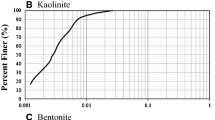Abstract
Soil venting is an effective and widely used method to remediate soils contaminated with hydrocarbons. A set of experiments was conducted in a one-dimensional soil column test section to investigate the effect of preheating the air in a soil venting system. Diesel fuel, which was used as the only contaminant, was analyzed and modeled with 14 major components. Temperature readings from the thermocouples, located in the test section were recorded during the experiment and the composition of hydrocarbons in the effluent air was also monitored. The results show that the diesel components are removed according to their volatility with the higher volatility components being removed first. An increase in venting air flow rate or inlet air temperature can considerably speed up the process. The increase in inlet air temperature is very effective in increasing the removal rate of the heavier components. A one-dimensional, non-isothermal, complete mixing model was used to predict the evaporation rates of the contaminant components and temperature distribution in the test section. Model results have been found to be in good agreement with the experimental data.
Similar content being viewed by others
References
Fotinich, A., 1997, “Experimental Investigation of Remediation of Soils Contaminated With Diesel Fuel,” Master of Science Thesis, University of California at Los Angeles, CA, U. S. A.
Fotinich, A., Joo, Y. and Dhir, V. K., 1996, “Investigation of Remediation of Soil Contaminated with Diesel Fuel Using Air Venting,”Proc. International Mechanical Engineering Congress and Exposition, Atlanta, Georgia, Nov. 17–22.
Griest, W. H., Higgins, C. E. and Guerin, M. R., 1986, “Comparative Chemical Characterization of Shale Oil-and Petroleum-Derived Diesel Fuels,”CONF-851027-5.
Lingineni, S. and Dhir, V. K., 1992, “Modeling of Soil Venting Processes to Remediate Unsaturated Sils,”Journal of Environmental Enginering, Vol. 118, pp. 135–152.
Mackay, D., 1988, “The Chemistry and Modeling of Soil Contamination with Petrolium,” inSoils Contaminated by Petroleum: Environmental and Public Health Effects (Edited by Calabrese, E. J., Kostecki, P. T. and Fleischer E. J.), John Wiley & Sons, New York.
Millner, G. C., Nye, A. C. and James, R. C., 1992, “Human Health Based Soil Cleanup Guidelines for Diesel Fuel No. 2,” inContaminated Soil-Diesel Fuel Contamination (Edited by Kostecki, P. T. and Calabrese, E. J.), Lewis Publisher, Boca Raton.
Reid, R. C., Prausnitz, J. M. and Poling, B. E., 1987,The Properties of Gases and Liquids, 4th edition, McGraw-Hill, New York.
Rose, W., 1958, “Volumes and Surface Areas of Pendular Rings,”Journal of Applied Physics, Vol. 29, No. 4, pp. 687–691.
Author information
Authors and Affiliations
Rights and permissions
About this article
Cite this article
Joo, Y., Fotinich, A. & Dhir, V.K. Remediation of contaminated soil with diesel by soil venting technique. KSME International Journal 12, 1174–1183 (1998). https://doi.org/10.1007/BF02942591
Received:
Issue Date:
DOI: https://doi.org/10.1007/BF02942591



